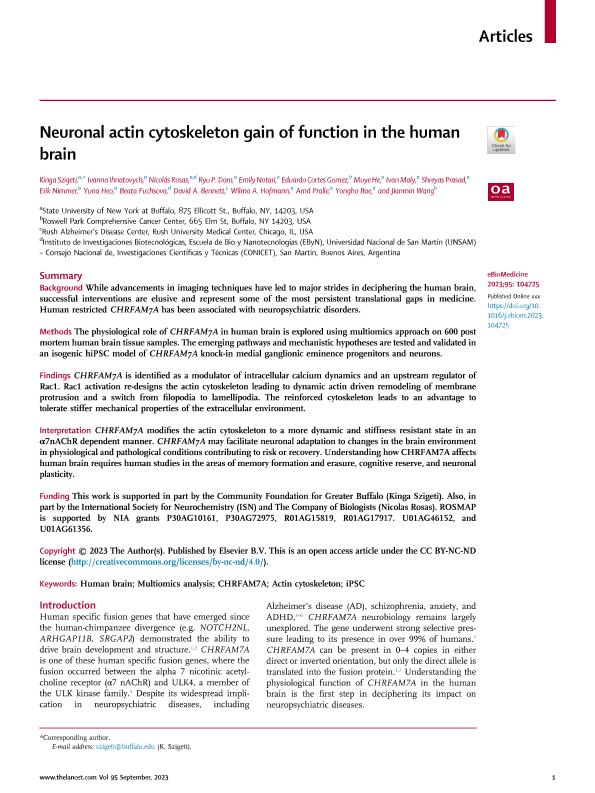Mostrar el registro sencillo del ítem
dc.contributor.author
Szigeti, Kinga
dc.contributor.author
Ihnatovych, Ivanna
dc.contributor.author
Rosas, Nicolás Matías

dc.contributor.author
Dorn, Ryu P.
dc.contributor.author
Notari, Emily
dc.contributor.author
Cortes Gomez, Eduardo
dc.contributor.author
He, Muye
dc.contributor.author
Maly, Ivan
dc.contributor.author
Prasad, Shreyas
dc.contributor.author
Nimmer, Erik
dc.contributor.author
Heo, Yuna
dc.contributor.author
Fuchsova, Beata

dc.contributor.author
Bennett, David A.
dc.contributor.author
Hofmann, Wilma A.
dc.contributor.author
Pralle, Arnd
dc.contributor.author
Bae, Yongho
dc.contributor.author
Wang, Jianmin
dc.date.available
2024-02-29T13:35:22Z
dc.date.issued
2023-09
dc.identifier.citation
Szigeti, Kinga; Ihnatovych, Ivanna; Rosas, Nicolás Matías; Dorn, Ryu P.; Notari, Emily; et al.; Neuronal actin cytoskeleton gain of function in the human brain; Elsevier; eBioMedicine; 95; 104725; 9-2023; 1-15
dc.identifier.uri
http://hdl.handle.net/11336/228929
dc.description.abstract
Background: While advancements in imaging techniques have led to major strides in deciphering the human brain, successful interventions are elusive and represent some of the most persistent translational gaps in medicine. Human restricted CHRFAM7A has been associated with neuropsychiatric disorders. Methods: The physiological role of CHRFAM7A in human brain is explored using multiomics approach on 600 post mortem human brain tissue samples. The emerging pathways and mechanistic hypotheses are tested and validated in an isogenic hiPSC model of CHRFAM7A knock-in medial ganglionic eminence progenitors and neurons. Findings: CHRFAM7A is identified as a modulator of intracellular calcium dynamics and an upstream regulator of Rac1. Rac1 activation re-designs the actin cytoskeleton leading to dynamic actin driven remodeling of membrane protrusion and a switch from filopodia to lamellipodia. The reinforced cytoskeleton leads to an advantage to tolerate stiffer mechanical properties of the extracellular environment. Interpretation: CHRFAM7A modifies the actin cytoskeleton to a more dynamic and stiffness resistant state in an α7nAChR dependent manner. CHRFAM7A may facilitate neuronal adaptation to changes in the brain environment in physiological and pathological conditions contributing to risk or recovery. Understanding how CHRFAM7A affects human brain requires human studies in the areas of memory formation and erasure, cognitive reserve, and neuronal plasticity. Funding: This work is supported in part by the Community Foundation for Greater Buffalo (Kinga Szigeti). Also, in part by the International Society for Neurochemistry (ISN) and The Company of Biologists (Nicolas Rosas). ROSMAP is supported by NIA grants P30AG10161, P30AG72975, R01AG15819, R01AG17917. U01AG46152, and U01AG61356.
dc.format
application/pdf
dc.language.iso
eng
dc.publisher
Elsevier

dc.rights
info:eu-repo/semantics/openAccess
dc.rights.uri
https://creativecommons.org/licenses/by-nc-nd/2.5/ar/
dc.subject
ACTIN CYTOSKELETON
dc.subject
CHRFAM7A
dc.subject
HUMAN BRAIN
dc.subject
IPSC
dc.subject
MULTIOMICS ANALYSIS
dc.subject.classification
Bioquímica y Biología Molecular

dc.subject.classification
Ciencias Biológicas

dc.subject.classification
CIENCIAS NATURALES Y EXACTAS

dc.title
Neuronal actin cytoskeleton gain of function in the human brain
dc.type
info:eu-repo/semantics/article
dc.type
info:ar-repo/semantics/artículo
dc.type
info:eu-repo/semantics/publishedVersion
dc.date.updated
2024-02-28T10:13:51Z
dc.identifier.eissn
2352-3964
dc.journal.volume
95
dc.journal.number
104725
dc.journal.pagination
1-15
dc.journal.pais
Reino Unido

dc.journal.ciudad
Londres
dc.description.fil
Fil: Szigeti, Kinga. State University of New York; Estados Unidos
dc.description.fil
Fil: Ihnatovych, Ivanna. State University of New York; Estados Unidos
dc.description.fil
Fil: Rosas, Nicolás Matías. Universidad Nacional de San Martín. Instituto de Investigaciones Biotecnológicas. - Consejo Nacional de Investigaciones Científicas y Técnicas. Oficina de Coordinación Administrativa Parque Centenario. Instituto de Investigaciones Biotecnológicas; Argentina. State University of New York; Estados Unidos
dc.description.fil
Fil: Dorn, Ryu P.. State University of New York; Estados Unidos
dc.description.fil
Fil: Notari, Emily. State University of New York; Estados Unidos
dc.description.fil
Fil: Cortes Gomez, Eduardo. Roswell Park Comprehensive Cancer Center; Estados Unidos
dc.description.fil
Fil: He, Muye. State University of New York; Estados Unidos
dc.description.fil
Fil: Maly, Ivan. State University of New York; Estados Unidos
dc.description.fil
Fil: Prasad, Shreyas. State University of New York; Estados Unidos
dc.description.fil
Fil: Nimmer, Erik. State University of New York; Estados Unidos
dc.description.fil
Fil: Heo, Yuna. State University of New York; Estados Unidos
dc.description.fil
Fil: Fuchsova, Beata. Universidad Nacional de San Martín. Instituto de Investigaciones Biotecnológicas. - Consejo Nacional de Investigaciones Científicas y Técnicas. Oficina de Coordinación Administrativa Parque Centenario. Instituto de Investigaciones Biotecnológicas; Argentina
dc.description.fil
Fil: Bennett, David A.. Rush University Medical Center (rumc);
dc.description.fil
Fil: Hofmann, Wilma A.. State University of New York; Estados Unidos
dc.description.fil
Fil: Pralle, Arnd. State University of New York; Estados Unidos
dc.description.fil
Fil: Bae, Yongho. State University of New York; Estados Unidos
dc.description.fil
Fil: Wang, Jianmin. Roswell Park Comprehensive Cancer Center; Estados Unidos
dc.journal.title
eBioMedicine
dc.relation.alternativeid
info:eu-repo/semantics/altIdentifier/doi/http://dx.doi.org/10.1016/j.ebiom.2023.104725
dc.relation.alternativeid
info:eu-repo/semantics/altIdentifier/url/https://www.sciencedirect.com/science/article/pii/S2352396423002906
Archivos asociados
